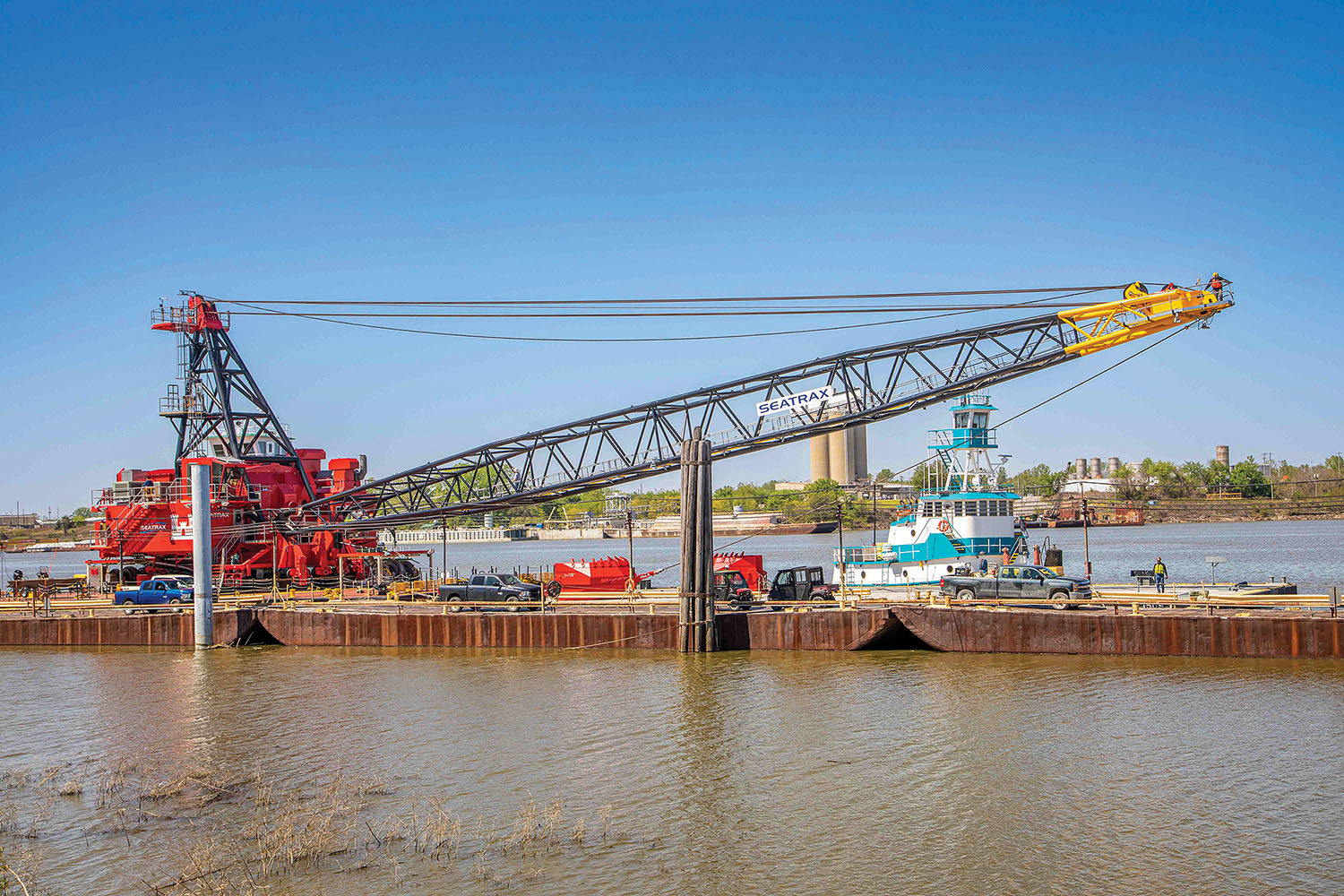After three years of work and $25.5 million, the Memphis Engineer District’s new Bank Grading Unit (BGU) has arrived.
The BGU was delivered April 11, docking at its new home at Ensley Engineer Yard in Memphis, Tenn. It replaces a 74-year-old unit as an essential part of revetment work along the Lower Mississippi. After clearing brush and debris from the riverbank, a process known as clearing and snagging, the BGU allows the Corps to smoothly slope the riverbank at an angle designed to keep it stable before the Vicksburg Engineer District’s mat-sinking unit places an articulated concrete mattress on top, from the beginning of the angled edge to the bank’s “toe,” where it begins to flatten out on the bottom. The unit will be named Grader 1.
Col. Brian Sawser, commander of the Memphis Engineer District, said the work of the revetment team is important for two reasons.
“I think most people think bank stabilization is for navigation purposes, but it actually has a dual purpose,” he said. “It’s for navigation and also flood mitigation. The Mississippi wants to move, as it has for centuries.”
Without the revetment work and the regional channel improvement project–through which the Memphis, Vicksburg and New Orleans districts work together–over time the Mississippi would cut a new course, changing the channel and potentially damaging levees that protect communities.
The Corps has sculpted the course of the Lower Mississippi through revetment and the placement of dikes for nearly 100 years.
“We were utilizing willow matting, essentially willow branches woven together like baskets,” Sawser said of early revetment efforts. Then the Corps moved to using asphalt in the 1940s before eventually switching to concrete mats in the 1950s.
“Revetment is a series of activities that I’ve certainly gained an appreciation for, coming into this command,” Sawser said.
He noted that the work the Corps is doing to stabilize the riverbanks for years to come helps protect $1 trillion in economic activity up and down the river system annually and the more than 30 inland ports that serve as “on-ramps” for the transportation of goods in the most cost-effective and environmentally friendly mode: using towboats and barges.
“The river gives us a strategic economic advantage,” Sawser said, adding, “It’s a vital national interest.”
Modernizing Equipment
Memphis District Regional Channel Improvement Project Manager Jake Storz described the Bank Grading Unit as somewhat resembling a barge-mounted crane, in that it has a boom. However, it is able to throw out a gigantic bucket with one cable and pull it back in toward the barge with another cable.
A towboat, usually the Memphis district’s mv. George C. Grugett, pushes it up and down the river, Memphis District Channel Improvement Project Manager Zach Cook said.
Storz and Cook described some of the features of the new BGU. They include a bigger bucket, with a 25-cubic-yard capacity. That means it is able to bite off 10 additional cubic yards of material at a time compared to the previous 1949 model. It also uses a 2,000 hp., 1.5-megawatt Caterpillar Tier 4 diesel generator, making it more environmentally friendly. To meet Tier 4 standards, diesel exhaust fluid (DEF) is injected into the exhaust stream to convert pollutants into water, oxygen and nitrogen and, at the same time, reduce two exhaust pollutants: particulate matter and oxygen nitrates.
The generator is a diesel locomotive engine turned upside down and fitted specifically for this use. Grader 1 weighs 1.1 million pounds. The BGU’s frame reaches 67 feet above the deck of the barge. The boom also has a longer reach than its predecessor, 200 feet instead of 185.
The district awarded two separate contracts for Grader 1, with funding allocated from Mississippi River and Tributaries Channel Improvement Revetment Construction Funding. In 2019, supplemental funds were made available to support replacement of the Vicksburg Engineer District’s mat-sinking unit with a new unit, to be called Armor 1. Armor 1 is still under construction but is expected to be complete and ready for use for the 2024 revetment season. Until then, Grader 1 will work with the existing mat-sinking unit. The first BGU contract, for the unit’s dragline machine, was awarded to Seatrax Inc. of Houston, Texas, in July 2019. A second contract, for the unit’s barge, was awarded to Conrad Shipyard of Morgan City, La., in September 2019. Both contractors worked together with technical support from the Philadelphia Engineer District’s Marine Design Center and the Memphis District team to complete and deliver the unit.
Grader 1 will be field-tested this spring and summer.
The 1949 barge-mounted Bucyrus-Erie dragline model it replaces is being retired.
“In past years, the legacy BGU has had major maintenance issues midseason, causing the Regional Channel Improvement Team to modify the season to allow for the continuation of sinking articulated concrete mattress on the Mississippi River,” Storz said.
Andrew Smothers, channel improvement project coordinator for the Memphis district, said the condition of that unit was the greatest challenge for the revetment team in 2022.
“For example, the (vintage) bank grader was down a total of 26 days due to catastrophic engine failure,” he said.
Cook said the new BGU will ultimately help to create a safe, reliable river channel and do so more efficiently, faster, without as much downtime, with fewer maintenance costs and in a way that is better for the environment.
Although details have not been finalized, a christening for Grader 1 is planned for May 2 in the Memphis area.
Jessica Haas, public affairs specialist with the Memphis Engineer District, contributed to this report.




